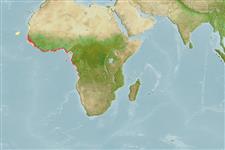Environment: milieu / climate zone / depth range / distribution range
Ecología
marino; salobre demersal; rango de profundidad 1 - 60 m (Ref. 4438). Tropical; 21°N - 17°S
Eastern Central Atlantic: Senegal to Congo (Ref. 114953).
Tamaño / Peso / Age
Maturity: Lm ? range ? - ? cm
Max length : 100.0 cm WD macho / no sexado; (Ref. 3170); common length : 60.0 cm WD macho / no sexado; (Ref. 26999); peso máximo publicado: 20.0 kg (Ref. 81259)
Vértebra: 130. Diagnosis: A large Dasyatis species most closely related to the much smaller Dasyatis margaritella and to the extremely flat D. garouaensis (Ref. 26277). Pearl spines always present and very large; denticles on dorsal surface of disc smooth, restricted to middle portion (Ref. 26277).
Dasyatis margarita is a coastal marine species, entering lagoons, shallow bays and estuaries (Ref. 3497, 81259). Feeds on shrimps, crabs, bivalves and annelids (Ref. 28587). Ovoviviparous (Ref. 50449).
Life cycle and mating behavior
Madurez | Reproducción | Puesta | Huevos | Fecundidad | Larva
Exhibit ovoviparity (aplacental viviparity), with embryos feeding initially on yolk, then receiving additional nourishment from the mother by indirect absorption of uterine fluid enriched with mucus, fat or protein through specialised structures (Ref. 50449). Distinct pairing with embrace (Ref. 205).
Capapé, C. and M. Desoutter, 1990. Dasyatidae. p. 59-63. In J.C. Quero, J.C. Hureau, C. Karrer, A. Post and L. Saldanha (eds.) Check-list of the fishes of the eastern tropical Atlantic (CLOFETA). JNICT, Lisbon; SEI, Paris; and UNESCO, Paris. Vol. 1. (Ref. 4438)
IUCN Red List Status (Ref. 130435)
Threat to humans
Harmless
Human uses
Pesquerías: comercial
Más información
ReferenciasAcuiculturaPerfil de acuiculturaRazasGenéticaElectrophoresesheritabilidadEnfermedadesProcesamientoNutrientsMass conversion
Herramientas
Special reports
Download XML
Fuentes de Internet
Estimates based on models
Preferred temperature (Ref.
123201): 23 - 28, mean 26.5 °C (based on 76 cells).
Phylogenetic diversity index (Ref.
82804): PD
50 = 0.5156 [Uniqueness, from 0.5 = low to 2.0 = high].
Bayesian length-weight: a=0.00832 (0.00366 - 0.01891), b=3.10 (2.90 - 3.30), in cm total length, based on LWR estimates for this (Sub)family-body shape (Ref.
93245).
Nivel trófico (Ref.
69278): 3.4 ±0.50 se; based on food items.
Resiliencia (Ref.
120179): Bajo, población duplicada en un tiempo mínimo de 4.5-14 años (Assuming fecundity<100).
Fishing Vulnerability (Ref.
59153): Very high vulnerability (90 of 100).
Nutrients (Ref.
124155): Calcium = 34.7 [8.3, 159.9] mg/100g; Iron = 0.765 [0.192, 2.007] mg/100g; Protein = 21.9 [19.0, 24.9] %; Omega3 = 0.174 [0.049, 0.512] g/100g; Selenium = 41.1 [11.0, 113.3] μg/100g; VitaminA = 13.3 [5.9, 29.3] μg/100g; Zinc = 1.1 [0.5, 2.0] mg/100g (wet weight);
